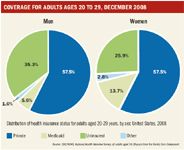Young adults have unmet health needs
Almost 13 million young adults did not have health insurance coverage in 2008. Although young adults are less likely to suffer from chronic conditions they have distinct healthcare needs.

"This is a group that has the highest uninsured rate," says Robin Cohen, one of the report's authors. "We wanted to see how insurance status impacts utilization of services. Even though we think of young adults as being relatively healthy, they are at risk."
The problem is particularly acute for young men. The data showed young men were 36% more likely than young women to be uninsured. That discrepancy is due largely to the fact that young women were more than twice as likely to be covered by Medicaid: 13.7% vs. 5.6%.
Although young adults are less likely to suffer from the chronic conditions that plague their parents and grandparents, they have distinct healthcare needs, including unintended pregnancies, sexually transmitted diseases, substance abuse and accidents, to name a few.
Without insurance, those needs often go unmet. Cohen found young adults who lack insurance were about half as likely to have a usual source of medical care than young people covered by private insurance or Medicaid. In addition, more than one out of every five uninsured adults went without needed medical care during the previous year because of cost.
AVAILABLE BUT NOT AFFORDABLE
Finding an effective way to cover some of these 13 million people hasn't been easy, however. By the end of last year, 25 states had expanded dependent coverage mandates and 13 others had taken steps to adopt expanded coverage, according to a report on young adult coverage published in January by the Robert Wood Johnson Foundation.
Unfortunately, greater availability of coverage didn't dramatically reduce the ranks of the uninsured, says Joel Cantor, director of the Rutgers University Center for State Health Policy and the report's lead author. Rather than increasing coverage rates, states with expanded dependent coverage saw a decline in the number of young adults covered under their own names.
Although the recent legislation will roll out over time, one of the provisions that applies this year calls for insurers to offer adults up to age 26 continuation of coverage under a parent's plan if they are not offered coverage by an employer. As with the state mandates Cantor studied, the burden of paying for that coverage falls to members.
"The big nut to crack in covering the uninsured is affordability," Cantor says, and neither the state laws nor the finalized federal reform legislation "broach the affordability barrier." Until federally mandated coverage kicks in in 2014, he says, "we won't see this moving the needle on insuring young adults."
-Shelly Reese
Commentary is independent of source data.
Conversations With Perry and Friends
April 14th 2025Perry Cohen, Pharm.D., a longtime member of the Managed Healthcare Executive editorial advisory board, is host of the Conversations with Perry and Friends podcast. His guest this episode is John Baackes, the former CEO of L.A. Care Health Plan.
Listen
Ohio’s Medicaid Work Requirement Efforts Aim to Boost Engagement, Avoid Coverage Loss
April 18th 2025Maureen Corcoran, director of the Ohio Department of Medicaid, believes the work requirement policy can be both a financial and moral effort to improve the lives of Medicaid consumers.
Read More
Breaking Down Health Plans, HSAs, AI With Paul Fronstin of EBRI
November 19th 2024Featured in this latest episode of Tuning In to the C-Suite podcast is Paul Fronstin, director of health benefits research at EBRI, who shed light on the evolving landscape of health benefits with editors of Managed Healthcare Executive.
Listen
Why Better Data and Awareness Matters for Medicaid Work Requirements
April 17th 2025With policymakers considering work requirements for Medicaid eligibility, Jennifer Haley, principal research associate in the Health Policy Division at the Urban Institute, said it’s more important than ever to understand how those changes could unintentionally cause harm, particularly when data systems fall short and public awareness is limited.
Read More